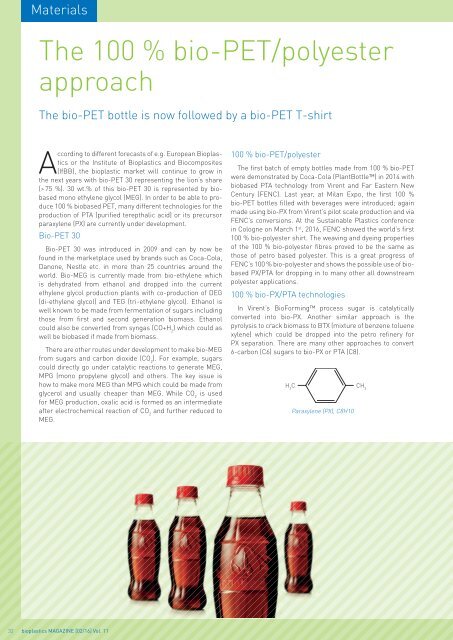Issue 02/2016
bioplasticsMAGAZINE_1602
bioplasticsMAGAZINE_1602
You also want an ePaper? Increase the reach of your titles
YUMPU automatically turns print PDFs into web optimized ePapers that Google loves.
Materials<br />
The 100 % bio-PET/polyester<br />
approach<br />
The bio-PET bottle is now followed by a bio-PET T-shirt<br />
According to different forecasts of e.g. European Bioplastics<br />
or the Institute of Bioplastics and Biocomposites<br />
(IfBB), the bioplastic market will continue to grow in<br />
the next years with bio-PET 30 representing the lion’s share<br />
(> 75 %). 30 wt.% of this bio-PET 30 is represented by biobased<br />
mono ethylene glycol (MEG). In order to be able to produce<br />
100 % biobased PET, many different technologies for the<br />
production of PTA (purified terepthalic acid) or its precursor<br />
paraxylene (PX) are currently under development.<br />
Bio-PET 30<br />
Bio-PET 30 was introduced in 2009 and can by now be<br />
found in the marketplace used by brands such as Coca-Cola,<br />
Danone, Nestle etc. in more than 25 countries around the<br />
world. Bio-MEG is currently made from bio-ethylene which<br />
is dehydrated from ethanol and dropped into the current<br />
ethylene glycol production plants with co-production of DEG<br />
(di-ethylene glycol) and TEG (tri-ethylene glycol). Ethanol is<br />
well known to be made from fermentation of sugars including<br />
those from first and second generation biomass. Ethanol<br />
could also be converted from syngas (CO+H 2<br />
) which could as<br />
well be biobased if made from biomass.<br />
There are other routes under development to make bio-MEG<br />
from sugars and carbon dioxide (CO 2<br />
). For example, sugars<br />
could directly go under catalytic reactions to generate MEG,<br />
MPG (mono propylene glycol) and others. The key issue is<br />
how to make more MEG than MPG which could be made from<br />
glycerol and usually cheaper than MEG. While CO 2<br />
is used<br />
for MEG production, oxalic acid is formed as an intermediate<br />
after electrochemical reaction of CO 2<br />
and further reduced to<br />
MEG.<br />
100 % bio-PET/polyester<br />
The first batch of empty bottles made from 100 % bio-PET<br />
were demonstrated by Coca-Cola (PlantBottle) in 2014 with<br />
biobased PTA technology from Virent and Far Eastern New<br />
Century (FENC). Last year, at Milan Expo, the first 100 %<br />
bio-PET bottles filled with beverages were introduced; again<br />
made using bio-PX from Virent’s pilot scale production and via<br />
FENC’s conversions. At the Sustainable Plastics conference<br />
in Cologne on March 1 st , <strong>2016</strong>, FENC showed the world’s first<br />
100 % bio-polyester shirt. The weaving and dyeing properties<br />
of the 100 % bio-polyester fibres proved to be the same as<br />
those of petro based polyester. This is a great progress of<br />
FENC’s 100 % bio-polyester and shows the possible use of biobased<br />
PX/PTA for dropping in to many other all downstream<br />
polyester applications.<br />
100 % bio-PX/PTA technologies<br />
In Virent’s BioForming process sugar is catalytically<br />
converted into bio-PX. Another similar approach is the<br />
pyrolysis to crack biomass to BTX (mixture of benzene toluene<br />
xylene) which could be dropped into the petro refinery for<br />
PX separation. There are many other approaches to convert<br />
6-carbon (C6) sugars to bio-PX or PTA (C8).<br />
H 3<br />
C CH 3<br />
Paraxylene (PX), C8H10<br />
32 bioplastics MAGAZINE [<strong>02</strong>/16] Vol. 11


















